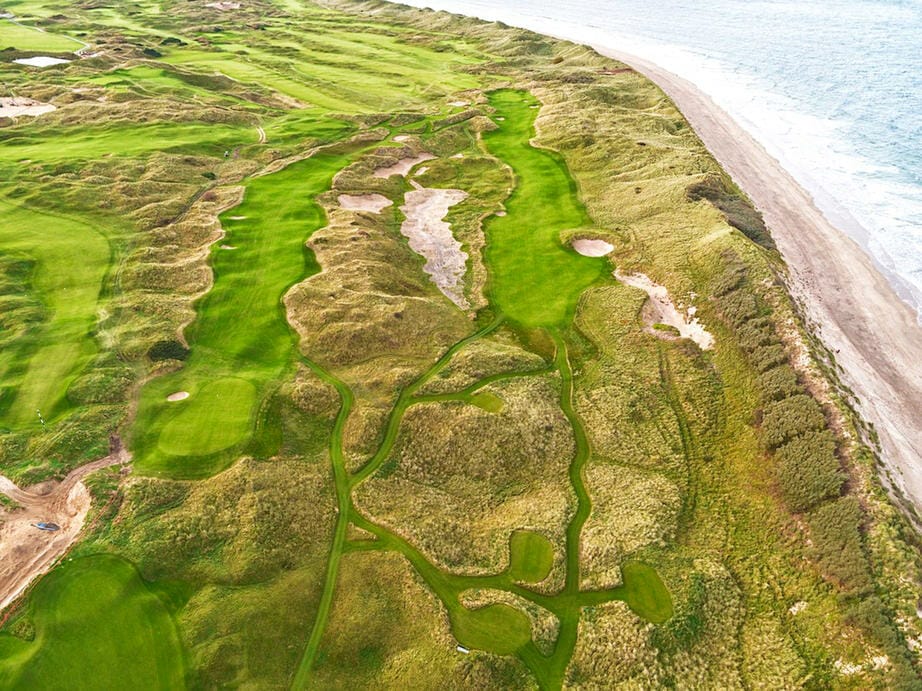Preparing for an Open doesn’t start the day after the previous one ends. In the case of the venue for 2019, it began even earlier. Five years ago, in fact – 72 months before the first ball will be struck in that year’s championship. That was when then-R&A chief Peter Dawson and his preferred course architect Martin Ebert took a stroll round the Dunluse links. It was when the dream of The Open returning to Royal Portrush for the first time since 1951 started to become more than just an idea.
That day, Ebert pointed out to Dawson the terrain – majestic, towering duneland at that – on which two new holes could be built to give the venue the space essential for the circus that is always part of a modern-day major.
Dawson, not a man to be dazzled easily, was impressed. But he wasn’t convinced and was eager to see how the links stood up to the task of hosting that summer’s Irish Open.
The R&A went “almost in disguise” as Ebert says, to monitor how it went. Record crowds flocked across the links and no-one was suggesting a Portrush Open wouldn’t be an epic Open. But could it actually be pulled off?
Ebert was asked to assess the course and his report two years later was the cornerstone for Portrush’s final push. Meanwhile, the club’s secretary Wilma Erskine – a smart, dynamic woman – rallied the Northern Irish government for backing (there are rumours of her camping outside First Minister Arlene Foster’s office) to help deliver the £55m+ influx an Open can provide.
On October 20, 2015, it was official; The Open was going to Portrush in 2019 – and, if it was a success, for at least a couple of other Opens after that. But that’s the thing; getting The Open was a great achievement, but it was only the beginning of the effort.
Now, Ebert’s plans for the course had to be implemented – and the faith of the R&A rewarded. It has resulted in a bit more than the usual bunker restoration and new back tee that a course gets prior to hosting The Open. Instead, a mammoth overhaul has seen key changes:
- Two brand-new holes created, by stealing ground from the club’s Valley course
- Losing the old 17th and 18th in order that their land could house the tented village
- A totally new second green to lengthen the par 5 by 40 yards
- The existing 9th, now the 11th, to play as a par 4 of 480 yards, taking the overall par to 71 The10th,now the 12th,stays as a par 5but has new back tees to the left of the preceding green, adding 54 yards
- A new back tee for ‘Calamity’ adding 35 yards to the legendary par 3 (now the 16th)
- Over all yardage up to 7,337 from 7,143(but three yards shorter off the whites)
- Nine holes with new fairway bunkers to tighten landing zones (although it still has only 62; a lot less than at other Open venues, which usually have 100+)
Those who know Portrush will realise from that list that the work centred on the current par 5s – 2nd (lengthened), 9th (now a par 4), 10th (lengthened) and 17th (gone). They were simply too short by modern standards.
Ebert has painstakingly researched the history of the links to remain as true to what Harry Colt envisaged in 1929 as is possible. The second green, for example, remained in play when the new one 40 yards back was created, allowing Ebert and his shapers to “copy” Colt. The only changes to the par 3s – always Colt’s stand-out holes – are the new tee on ‘Calamity’ and a resurfaced 3rd green.
Despite working through two of the wettest winters on record the work is now finished. It looks magnificent, and it’s hard to pinpoint the seams. Helping the new blend with the old (and to fall in line with NI’s environmental agency), they’ve used a very skilful and painstaking recycling operation.
All fairways, greens and even the marram grass rough has been moved from one area of the site to where it was required. Remarkably, the only imported turf was for grass paths and tee surfaces.
How have they done it? Using the skill of expert shaper Marcus Terry and a cutting disc you’d usually see used on Tarmac. It attaches to the end of a digger’s arm and looks like a big pizza slicer. They cut slabs of turf with it into squares about 1.5m2 and nine inches thick. They then swapped the disc for a 5ft bucket with hay forks on it, that allowed them to lift up the slabs one by one and transport two at a time in a 10-tonne dump truck.
Everything survives; the marram grass, the fescue, the wild flowers… it just starts growing in its new location. It was a slow and delicate process, but the seamless results are clear.
Getting the course “right” is only part of the deal, though. The beautiful undulations and enormous dunes that make it one of the world’s greatest tracks cause serious challenges for getting thousands of people around it.
For example, while the new holes enhance the course and give space for the tented village, they created a routing headache, adding a new tee and green at the already busiest point of the course. Even before the new 7th tee and 8th green were created, there were crossover points between the 6th and old 7th and the old 8th and 9th.
Now, there are three greens and three sets of tees just yards apart. It will be the point at which to view in 2019 – you’ll never not have some sort of action to watch – but it would be a logistical nightmare in regards to getting players around.
“There was talk of a bridge, but even just for that week it won’t look good on the landscape,” recalls Ebert. “Then I had a eureka moment; we had to put the players through a tunnel. From a germ of an idea there is now this incredible structure, which is landscaped all around with rough, so it is totally invisible.”
Located at the back of the par-3 6th green, the tunnel will be the players’ passage from the 8th green to the 9th tee and from the 10th green to the 11th tee. What then, about, the players’ practice facilities? The current driving range – fine for the Irish Open, but not good enough for an Open – will be used for the spectator village as it enjoys a central site. So more land was needed and the solution again involved the club’s other courses.
While creating three new holes for the Valley (two to replace the pair it lost to the Dunluce and one to improve the finale), those Valley changes also impinged on the par 3 nine-hole Skerries so it has been given two new stunning short holes. The Open practice tee has been positioned at the start of the fairway of the Valley’s 4th hole to give an almost 400-yard long, 90-yard wide range that the R&A believes will be one of best practice facilities they have. The players will be shuttled out there from their lounge, likely to be in the main clubhouse. A brand-new short- game green has also been built on virgin ground next to it, and one of Valley’s greens will be the practice putting green, because the R&A wants it all to be close together.
R&A officials have been visiting Portrush every six or seven weeks to check on infrastructure plans, service roads, and to ponder where the grandstands will go. Off the course, £500,000 is being spent refurbishing the centre of this vibrant seaside town, including an upgrade of the train station that will be a key transport link in July 2019.
Two new stars of Royal Portrush – The 7th and 8th
To the untrained eye, they look as though they’ve been in place forever – or at the very least for 128 years. If you didn’t know, you’d swear they were holes cut from the land by Harry Colt back in 1889, when Royal Portrush extended its Dunluce course from nine holes to 18 to create one of the world’s greatest links.

In reality, the two holes on this aerial shot have been in place only a matter of months. If you didn’t know, you wouldn’t know. “That’s always the biggest compliment we could have,” says Martin Ebert, of Mackenzie & Ebert, the architects tasked with the job of creating these two new holes. “If it looks natural, then we’ve done our jobs well.”
Stealing land from the adjacent Valley Course, the two new tests – the 7th and 8th – replace the Dunluce’s 17th and 18th holes, removed entirely to free up land needed for the spectator village and infrastructure when the Open finally returns in 2019. “We’re very pleased with how it’s gone,” says Ebert. Judging from the air, it’s easy to see why.
“FINISHING WHAT HARRY COLT BEGAN”
Martin Ebert tells Irish Golfer how he hopes to have improved a masterpiece
People will be hard pushed to know what we’ve actually been in and done on these two holes at Portrush, because it all looks like a very natural landscape. That’s the biggest compliment we could hear when it comes to changing a course, because if you can avoid moving things, you should.
The 7th 590 yards, par 5
From the 6th green, it’s a beautiful walk into the dunes to the 7th tees. We didn’t really touch those dunes, we just nestled those tees in there. What you get is a beautiful downhill tee shot, with that big bunker lurking on the right. Losing the 17th on the old course meant losing the ‘Big Nellie’ bunker – this is a replacement for that. It
will be fascinating to see how many players take that bunker on. The real intention is to encourage people to be aggressive and to get as close to the green on the tee shot as they can. From the landing area on the fairway there’s a gentle incline up to a green that has the feel of the 1st – there’s some real undulation and an emphasis on accuracy. While the landscape was great for adding two new holes, every inch from the start of the fairways up to the greens needed to be shaped to make them
suitable for play, for the Open and for spectators to get around. The challenge was to make them look natural despite the work.
I think we’ve done that and the 7th will be a stunning place to watch the Open, with spectators down the right-hand side. The views from there are just stunning.
The 8th 430 yards, par 4
The new 8th is a real daring dog-leg, right to left, where it will be fascinating to see how many take the corner on to leave themselves with 100 yards or less into the green. The problem you have in doing that is that there are some very steep dune banks to the left that can punish you. The fairway itself undulates beautifully and ties into its surroundings. Playing into the green, there’s a very significant bank front left. You can run it in front right but if you go left you’ve got a steep bank that will definitely punish you.
Completing Colt’s classic
The hope with these changes is that Portrush will have 18 classic duneland holes, rather than the previous view that it perhaps had 16 fantastic holes with the last two a little bit ‘added on’. We’d like to think that if Harry Colt came back today, he’d think that we’d completed the picture for him. We hope he’d be pleased with what we’ve done.
Priority tickets for the 148th Open Championship are now available to purchase, click below to secure yours now.

























Leave a comment